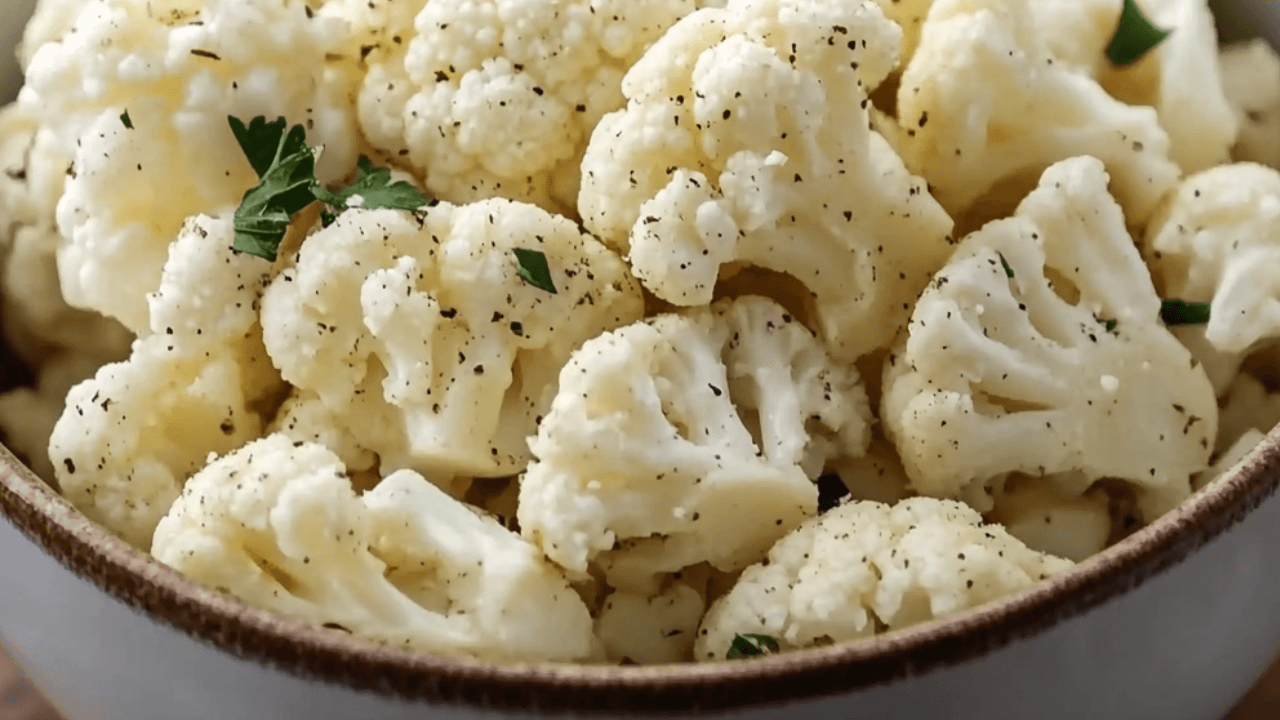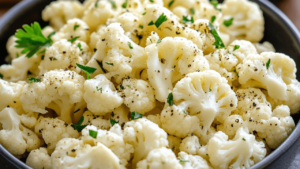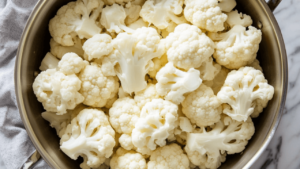Should we boil cauliflower before cooking? Cooking methods can make or break your dish, and cauliflower is no exception. Boiling cauliflower before cooking it further is a common practice, but is it the best approach? This article will explore various perspectives on this topic, offering insights and practical advice for cauliflower enthusiasts.
Cauliflower is a nutritional powerhouse, rich in vitamins and minerals. However, how you cook it can affect its health benefits. Some argue that boiling preserves nutrients and improves digestibility, while others believe it leads to nutrient loss and altered texture. Understanding these differing viewpoints can help you make an informed decision about your cooking methods.
- Importance of the topic: Why it’s crucial to understand the best way to cook cauliflower.
- Brief overview of the debate: The pros and cons of boiling cauliflower.
Understanding Cauliflower
Nutritional Benefits of Cauliflower
Cauliflower is a nutrient-dense vegetable, offering numerous health benefits. It’s low in calories yet high in vitamins, including C, K, and several B vitamins. Additionally, it provides a good amount of fiber, antioxidants, and phytonutrients, which contribute to its numerous health benefits.
- Nutritional content: Vitamins, minerals, and antioxidants in cauliflower.
- Health benefits: How cauliflower supports a healthy diet.
Cauliflower Cooking Methods
When it comes to cooking cauliflower, there are several methods to choose from, each with its unique benefits and drawbacks. Boiling, steaming, roasting, and sautéing are popular techniques that can yield different results in terms of flavor, texture, and nutritional retention.
- Boiling: Quick and easy but may lead to nutrient loss.
- Steaming: Retains more nutrients compared to boiling.
- Roasting: Enhances flavor through caramelization.
- Sautéing: Offers a quick cooking method with minimal nutrient loss.
Choosing the right cooking method depends on your nutritional goals and taste preferences. For example, if you want to retain the maximum nutrients, steaming or sautéing might be your best bet.
The Case for Boiling
Advantages of Boiling Cauliflower
Should we boil cauliflower before cooking? Boiling cauliflower comes with several benefits, making it a preferred method for some home cooks and chefs. Here are some of the notable advantages:
- Nutrient Retention: Contrary to popular belief, boiling can help retain certain nutrients like glucosinolates, which are beneficial compounds found in cruciferous vegetables. While some vitamins may be lost, others are preserved.
- Improved Digestibility: Boiling breaks down tough fibers, making cauliflower easier to digest. This is particularly beneficial for individuals with sensitive digestive systems or those who experience bloating from raw vegetables.
- Quick and Efficient: Boiling is a straightforward and quick cooking method. It requires minimal preparation and cooking time, making it ideal for busy individuals or quick weeknight meals.
- Versatile Pre-Cooking Step: Boiling can serve as a pre-cooking step before incorporating cauliflower into other recipes. For instance, you might boil cauliflower before mashing it for a smooth, creamy texture or before adding it to soups and stews.
How to Boil Cauliflower Properly
To get the best results from boiling cauliflower, follow these steps to ensure optimal texture and nutrient retention:
- Preparation: Start by cutting the cauliflower into even-sized florets. This ensures uniform cooking and prevents some pieces from being overcooked while others remain undercooked.
- Water and Salt: Bring a large pot of water to a rolling boil. Adding a pinch of salt can enhance the cauliflower’s natural flavor.
- Boiling Time: Carefully add the cauliflower florets to the boiling water. For a tender texture, cook for about 5-7 minutes. If you prefer a firmer bite, reduce the cooking time slightly.
- Drain and Rinse: Once the cauliflower reaches the desired tenderness, drain it immediately. Rinsing with cold water stops the cooking process and helps preserve the texture.
Tips for Preserving Nutrients:
- Avoid overcooking the cauliflower, as this can lead to a mushy texture and increased nutrient loss.
- Use a large pot to ensure the cauliflower cooks evenly and quickly.
For more detailed guidance on alternative methods like roasting, you might find this resource helpful.
The Case Against Boiling
Disadvantages of Boiling Cauliflower
Should we boil cauliflower before cooking? While boiling has its benefits, there are several disadvantages to consider:
- Nutrient Loss: Boiling can cause water-soluble vitamins, such as vitamin C and some B vitamins, to leach into the water. This reduces the overall nutrient content of the cauliflower.
- Texture and Flavor Changes: Boiling can sometimes result in a bland, mushy texture. This method lacks the caramelization that roasting provides, which enhances the natural sweetness and flavor of cauliflower.
- Waterlogged: If not drained properly, boiled cauliflower can become waterlogged, affecting the texture and potentially making your dishes soggy.
Alternatives to Boiling
Given the potential downsides of boiling, exploring other cooking methods can yield better results for flavor, texture, and nutrient retention:
- Steaming: Steaming is an excellent alternative to boiling as it retains more nutrients and provides a crisp-tender texture.
- To steam, place cauliflower florets in a steamer basket over boiling water and cover. Steam for 5-7 minutes or until tender.
- Roasting: Roasting brings out a deep, rich flavor through caramelization, enhancing the natural sweetness of cauliflower.
- Toss florets with olive oil, salt, and pepper. Spread on a baking sheet and roast at 425°F (220°C) for 20-25 minutes.
- Sautéing: Sautéing provides a quick and flavorful option, preserving most of the nutrients while adding a delightful crispiness.
- Heat a bit of oil in a pan, add cauliflower, and cook for about 5-7 minutes, stirring frequently until tender and golden.
For more information on how to achieve perfect cauliflower side dishes, check out this recipe.
Expert Opinions and Scientific Studies
Expert Opinions on Boiling Cauliflower
The opinions on boiling cauliflower vary widely among experts. Some nutritionists and chefs have specific views on this cooking method:
- Nutritionists’ View: According to some dietitians, boiling can make cauliflower easier to digest and may be beneficial for individuals with certain dietary needs. However, they often recommend steaming as a better alternative for nutrient retention.
- Chefs’ Perspective: Many chefs prefer roasting or steaming over boiling to preserve flavor and texture. They highlight the benefits of caramelization in roasting, which brings out the natural sweetness and enhances the overall taste of the cauliflower.
Scientific Studies
Scientific research provides valuable insights into the impact of different cooking methods on cauliflower’s nutrient content. Studies have shown that steaming tends to retain the most nutrients, while boiling can lead to significant losses of water-soluble vitamins. However, some studies also indicate that boiling can help reduce certain antinutrients and make cauliflower more digestible.
Practical Tips for Cooking Cauliflower
Choosing the Best Cooking Method for Your Needs
When deciding how to cook cauliflower, consider your goals and preferences:
- For Maximum Nutrient Retention: Steaming is the best option.
- For Best Flavor: Roasting offers unparalleled taste through caramelization.
- For Quick Preparation: Boiling and sautéing are efficient and easy methods.
Think about what you value most in your dish—nutrients, flavor, or convenience—and choose the cooking method that best fits your needs.
Flavor Enhancements and Pairing Ideas
Enhancing the flavor of cauliflower can make it even more enjoyable. Here are some tips and pairing ideas:
- Seasoning: Use salt, pepper, garlic, and lemon juice to elevate the taste.
- Herbs and Spices: Experiment with paprika, turmeric, cumin, and parsley for a unique twist.
- Cheese: Adding parmesan or cheddar can create a creamy texture and rich flavor.
Pair boiled or steamed cauliflower with roasted chicken or mix it into a vegetable stir-fry for a balanced and nutritious meal.
Frequently Asked Questions (FAQs)
- Should I boil cauliflower before roasting?
- It’s not necessary, but parboiling can shorten roasting time and ensure even cooking.
- Does boiling cauliflower reduce its nutrients significantly?
- Yes, some nutrients, especially water-soluble vitamins, can be lost. Steaming is a better option for nutrient retention.
- How long should I boil cauliflower for the best texture?
- Boil for 5-7 minutes for tender yet firm florets.
- Is boiled cauliflower suitable for a low-carb diet?
- Absolutely. Cauliflower is low in carbs and fits well into a low-carb or keto diet.
- Can I boil cauliflower and then freeze it?
- Yes, but blanching it before freezing can help maintain its texture and nutrients.
Boiling Cauliflower for Specific Recipes
Using Boiled Cauliflower in Recipes
Boiling cauliflower can be a useful pre-cooking step for various recipes. Here are a few popular dishes where boiled cauliflower shines:
- Cauliflower Mash: Boiled cauliflower can be mashed with butter, cream, and seasoning to create a low-carb alternative to mashed potatoes.
- Cauliflower Soup: Adding boiled cauliflower to soups can create a creamy texture without the need for dairy.
- Cauliflower Rice: Boiled cauliflower can be pulsed in a food processor to make cauliflower rice, which is a great base for stir-fries and salads.
Step-by-Step Recipe: Creamy Cauliflower Mash
Here’s a simple recipe to make creamy cauliflower mash:
- Ingredients:
- 1 head of cauliflower, cut into florets
- 2 tablespoons of butter
- 1/4 cup of heavy cream
- Salt and pepper to taste
- Optional: garlic powder, shredded cheese
- Instructions:
- Boil the cauliflower florets in salted water for 5-7 minutes, until tender.
- Drain and transfer to a food processor.
- Add butter, cream, salt, and pepper.
- Blend until smooth and creamy.
- Adjust seasoning and add optional ingredients as desired.
Serve as a side dish with your favorite main course.
Cauliflower in Different Cuisines
Global Cauliflower Recipes
Cauliflower is a versatile vegetable that features prominently in many cuisines around the world. Here are some international dishes that highlight cauliflower:
- Aloo Gobi (India): A traditional Indian dish made with cauliflower and potatoes, seasoned with turmeric, cumin, and coriander.
- Cauliflower Gratin (France): A creamy, cheesy baked dish that showcases cauliflower in a rich béchamel sauce.
- Cauliflower Tacos (Mexico): Roasted cauliflower serves as a delicious filling for vegetarian tacos, topped with salsa and avocado.
Adapting Recipes for Boiled Cauliflower
While many of these recipes traditionally use roasted or sautéed cauliflower, you can adapt them to use boiled cauliflower for a different texture. For example, you can boil cauliflower before adding it to a curry or casserole to reduce cooking time and ensure even tenderness.
Recommended Internal Links
Here are three internal linking opportunities for the article « Should We Boil Cauliflower Before Cooking? » using relevant articles from Susie Recipes.
Cauliflower is a nutritional powerhouse, rich in vitamins and minerals. However, how you cook it can affect its health benefits. Some argue that boiling preserves nutrients and improves digestibility, while others believe it leads to nutrient loss and altered texture. Read more.
Choosing the right cooking method depends on your nutritional goals and taste preferences. For example, if you want to retain the maximum nutrients, steaming or sautéing might be your best bet. Explore more methods.
Nutrient Retention: Contrary to popular belief, boiling can help retain certain nutrients like glucosinolates, which are beneficial compounds found in cruciferous vegetables. Learn more.
Additional Resources and Readings
Cauliflower is a nutritional powerhouse, rich in vitamins and minerals. However, how you cook it can affect its health benefits. Some argue that boiling preserves nutrients and improves digestibility, while others believe it leads to nutrient loss and altered texture. Learn more about the nutritional benefits of cauliflower.
Nutrient Retention: Contrary to popular belief, boiling can help retain certain nutrients like glucosinolates, which are beneficial compounds found in cruciferous vegetables. Discover more about glucosinolates and their benefits.
Nutrient Loss: One of the major concerns with boiling is the potential loss of water-soluble vitamins, like vitamin C and some B vitamins, into the cooking water. Read about the impact of cooking methods on nutrient retention.
Conclusion
Should we boil cauliflower before cooking? Deciding whether to boil cauliflower before cooking ultimately depends on your specific culinary goals and preferences. Each cooking method has its unique advantages and drawbacks, making it essential to choose based on what you prioritize most—be it nutritional retention, flavor, or convenience.



